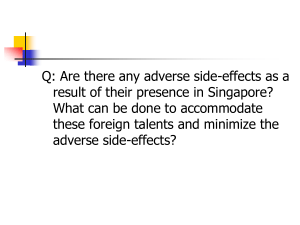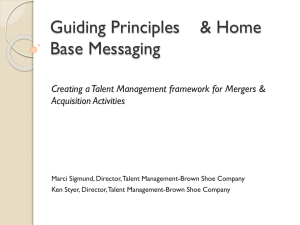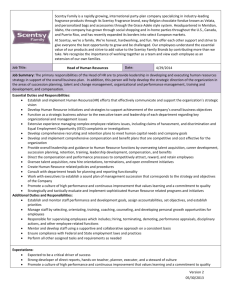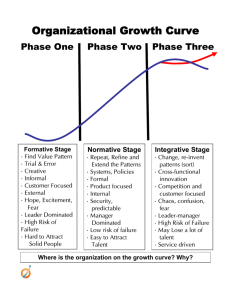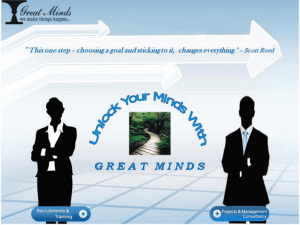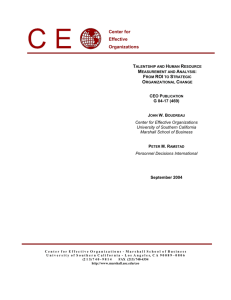Effective Human Resource Management: A Global Analysis Effective
advertisement
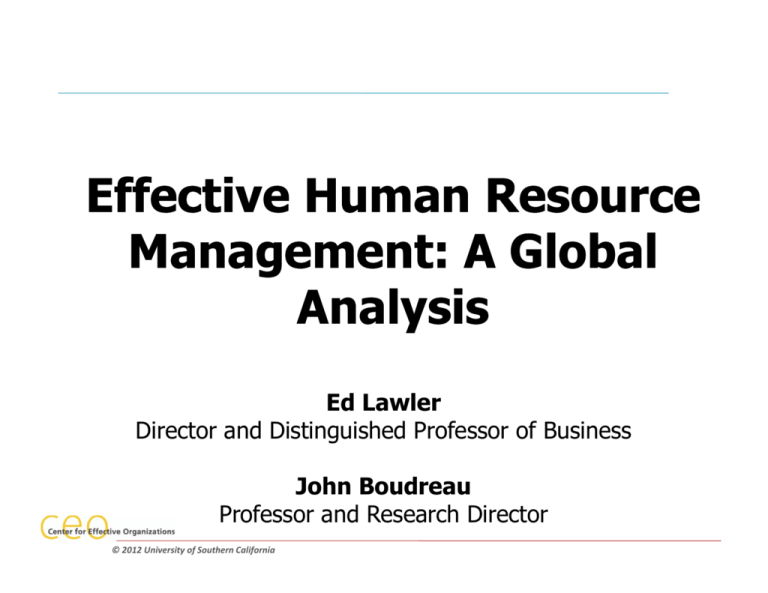
Effective Human Resource Management: A Global Analysis Ed Lawler Director and Distinguished Professor of Business John Boudreau Professor and Research Director © 2012 University of Southern California Some of Ed’s focuses Dr. Edward E. Lawler CEO Director and Distinguished Professor © 2012 University of Southern California • • • • • • HR management Compensation Organization development Board effectiveness Talent Recent books include Management Reset: Organizing for Sustainable Effectiveness (2011); Talent: Making People Your Competitive Advantage (2008) and the forthcoming Effective Human Resource Management: A Global Analysis (2) Some of John’s focuses • • Dr. John W. Boudreau Professor and CEO Research Director © 2012 University of Southern California • Bridge between superior human capital, talent and sustainable competitive advantage Works with companies worldwide to discover and maximize specific strategic bottom‐line impacts of superior people and human capital strategies Recent books include Effective Human Resource Management: A Global Analysis (forthcoming), Transformative HR: How Great Companies Use Evidence‐Based Change for Sustainable Advantage (with co‐author Ravin Jesuthasan, 2011) and Retooling HR: Using Proven Business Tools to Make Better Decisions About (2010). (3) Effective Human Resource Management: A Global Analysis By Edward E. Lawler III and John W. Boudreau (Stanford Press, 2012) © 2012 University of Southern California (4) Staff Functions … • Are “Businesses” that deliver value to the firm • Need a clear value proposition that contributes to the success of the business and its ability of the organization to carry out its strategy • Are designed to optimize value delivered from customer’s perspective • Are designed to fit the organization and business context • By virtue of how they function, they can foster or impede business strategy, help define and enrich, or constrain new strategic directions. ‐ Based on Mohrman and Worley © 2012 University of Southern California EL99W SM3P (5) HR As a Business With 3 Product Lines I. Basic Administrative Services and Transactions involved with compensating, hiring, training and staffing ‐‐‐ Emphasis on resource efficiency and service quality II. Business Partner Services involved with developing effective HR systems and helping implement business plans, talent management ‐‐‐ Emphasis on knowing the business and exercising influence‐‐solving problems, designing effective systems to ensure needed competencies. III. Strategic Partner Role contributing to business strategy based on considerations of human capital, and organizational capabilities, readiness, developing HR practices as strategic differentiators ‐‐‐ Emphasis on deep and broad knowledge of HR and of the Business, Competition and Market, and business strategies © 2012 University of Southern California EL100W (6) Business Partner Business Strategy HR Practices Org. Design Change Management HR Services Execution Implement Change © 2012 University of Southern California EL101W (7) Strategic Partner Human Capital and Business Data Business Strategy HR Practices © 2012 University of Southern California Org. Design Change Management EL102W (8) How is the HR team doing? © 2012 University of Southern California EL103W (9) Criticism of HR • Skinner, Wickham. (1981). Big Hat, No Cattle: Managing Human Resources.” Harvard Business Review. • Stewart, Thomas. (1996). “Taking on the Last Bureaucracy.” Fortune Magazine. Why not blow the sucker up? Improvement’s for wimps. I mean abolish it. Deep‐six it. • Hammond, Keith. (2005). “Why we Hate HR.” Fast Company © 2012 University of Southern California EL104W (10) CEO-HRPS Survey 2010 What HR Professionals Believe MEANS Maintaining Records Collect, track, and maintain data on employees 5 – 7 Years Ago Current 23.2 13.6 Significant Decrease 15.7 12.5 Significant Decrease 32.8 30.4 Significant Decrease 14.4 16.7 Significant Increase 13.9 26.8 Significant Increase Auditing/Controlling Ensure compliance to internal operations, regulations, and legal and union requirements Human Resources Service Provider Assist with implementation and administration of HR practices Development of HR Systems and Practices Develop new HR systems and practices Strategic Business Partner Member of the management team. Involved with strategic HR planning, organizational design, and strategic change Difference N=190 © 2012 University of Southern California EL105W (11) Relationship of Current HR Roles (Time Spent) and Organizational Performance Organizational Performance2 HR ROLES1 Maintaining Records Collect, track, and maintain data on employees Auditing/Controlling ‐.12 Ensure compliance to internal operations, regulations, and legal and union requirements ‐.13 Human Resources Service Provider ‐.23* Assist with implementation and administration of HR practices Development of Human Resources Systems and Practices Develop new HR systems and practices Strategic Business Partner Member of the management team. Involved with strategic HR planning, organizational design, and strategic change .16t .27** 1 Based on percentage of time spent on HR roles as rated by HR Executives. 2 Based on Response: 1 = Much below average; 2 = Somewhat below average; 3 = About average; 4 =Somewhat above average; 5 = Much above average. Significance Level: t p ≤ .10 * p ≤ .05 ** p ≤ .01 *** p ≤ .001 © 2012 University of Southern California EL106W (12) HR’s Actual Progress Since 1995 Percentage of Time Spent in the Role 1995 1998 2001 2004 2007 2010 Maintaining Employee Records 15.4 16.1 14.9 13.2 15.8 13.6 Auditing and Controlling, Ensuring Compliance 12.2 11.2 11.4 13.3 11.6 12.5 Providing HR Services and Implementing Programs 31.3 35.0 31.3 32.0 27.8 30.4 Developing HR Systems and Practices 18.6 19.2 19.3 18.1 19.2 16.7 Strategic Business Partner 22.0 20.3 23.2 23.5 25.6 26.8 © 2012 University of Southern California EL107W (13) Relationship of HR Strategy to Organizational Performance Organizational Performance HR STRATEGY Data‐based talent strategy .22* A human capital strategy that is integrated with business strategy .33*** Provides analytic support for business decision‐making .24** Provides HR data to support change management .23* Drives change management .20* Makes rigorous data based decisions about human capital management .18t Significance Level: t p ≤ .10 * p ≤ .05 ** p ≤ .01 *** p ≤ .001 © 2012 University of Southern California EL108W (14) HR’s Role in Business Strategy ROLE IN STRATEGY 1998 2001 2004 2007 2010 No Role 4.2 3.4 2.0 5.7 4.3 Implementation Role 16.8 11.6 12.2 17.0 17.4 Input Role 49.6 43.8 45.9 45.3 47.3 Full Partner 29.4 41.1 39.8 32.1 31.0 3.0 3.2 3.2 3.0 3.1 MEAN Percent Responding Means Response Scale: 1 = No Role to 4 = Full Partner © 2012 University of Southern California EL109W (15) HR’s Role in Business Strategy MEANS USA1 CANADA2 AUSTRALIA3 EUROPE4 UK5 CHINA6 No Role 4.3 2.2 9.4 4.6 2.2 15.5 Implementation Role 17.4 24.4 12.5 15.4 17.8 41.3 Input Role 47.3 42.2 40.6 56.9 42.2 37.6 Full Partner 31.0 31.1 37.5 23.1 37.8 5.6 3.056 3.026 3.066 2.986 3.166 2.3312345 ROLE IN STRATEGY MEAN 123456 Significant difference between countries (p≤.05) © 2012 University of Southern California EL110W (16) State of Human Resources Information System (HRIS) PERCENTAGES STATE OF INFORMATION SYSTEM USA1 CANADA2 AUSTRALIA3 EUROPE4 UK5 CHINA6 Little or No Information Technology/ Automation Present in the HR Function 3.8 13.6 23.3 11.3 18.6 41.8 Some HR Processes Are Information Technology Based/ Automated 30.1 31.8 23.3 33.9 39.5 19.2 Most Processes Are Information Technology Based/ Automated But Not Fully Integrated 49.7 43.2 43.3 38.7 30.2 27.7 Completely Integrated HR Information Technology/ Automated System 16.4 11.4 10.0 16.1 11.6 11.3 3.796 3.506 3.40 3.586 3.35 3.02124 Meana aResponse Scale: 1=No Information Technology; 2=Little Information Technology; 3=Some Processes Integrated; 4=Most Processes Integrated; 5=Completely Integrated 123456 Significant differences between countries (p ≤ .05). © 2012 University of Southern California EL111W (17) Relationship of Information System Use to Organizational Performance INFORMATION SYSTEM Organizational Performance1 Completely Integrated HR IT System 4.3 Most Processes are IT Based but not Fully Integrated 3.8 Some HR Processes are IT Based 3.7 Little IT Present in the HR Function 3.8 No IT Present No Responses 1Based on Response: 1 = Much below average; 2 = Somewhat below average; 3 = About average; 4 =Somewhat above average; 5 = Much above average. © 2012 University of Southern California (18) Relationship of HRIS Outcomes to Organizational Performance Organizational Performance HRIS OUTCOMES1 OVERALL Effectivenessa .21* Employee Satisfaction .13 Efficiency .22* Business Effectiveness .18* Improve Human Capital Decisions Of Managers Outside HR .20* Effective .13 Create Knowledge Networks .22* Build Social Networks That Help Get Work Done .24** a Includes items from Employee Satisfaction, Efficiency, and Business Effectiveness scales only. Significance Level: t p ≤ .10 * p ≤ .05 ** p ≤ .01 *** p ≤ .001 © 2012 University of Southern California (19) Relationship of HR Skill Satisfaction to Organizational Performance HR SKILLS1 Organizational Performance HR Technical Skills .25** Interpersonal Dynamics .29*** Business Partner Skills .23* Metrics Skills .17t Significance Level: t p ≤ .10 * p ≤ .05 ** p ≤ .01 *** p ≤ .001 © 2012 University of Southern California (20) Relationship of HR Analytics And Metrics Use to Organizational Performance Organizational Performance MEASURES1 EFFICIENCY Measure the financial efficiency of HR operations (e.g. cost‐per‐hire, time‐ to‐fill, training costs?) Collect metrics that measure the cost of HR Programs and Processes? Benchmark analytics and measures against data from outside organizations (e.g. Saratoga, Mercer, Hewitt, etc.)? EFFECTIVENESS Use HR dashboards or scorecards? Measure the specific effects of HR programs (such as, learning from training, motivation from rewards, validity of tests, etc.)? Have the capability to conduct cost‐benefit analyses (also called utility analyses) of HR programs? IMPACT Measure the business impact of HR programs and processes? Measure the quality of the talent decisions made by non‐HR leaders? Measure the business impact of high versus low performance in jobs? .13 .14 .09 .13 .20* .23* .34*** .04 .24** 1 Response Scale: 1 = Yes, have now; 2 = Being built; 3 = Planning for; 4 = Not currently being considered. Significance Level: t p ≤ .10 * p ≤ .05 ** p ≤ .01 *** p ≤ .001 © 2012 University of Southern California (21) Relationship of HR Metrics & Analytics Effectiveness to Organizational Performance Organizational Performance EFFECTIVENESS1 Strategy Contributions Contributing to decisions about business strategy and human capital management Identifying where talent has the greatest potential for strategic impact Connecting human capital practices to organizational performance Supporting organizational change efforts HR Functional and Operational Contributions Assessing and improving the HR department operations Predicting the effects of HR programs before implementation Pinpointing HR programs that should be discontinued Logic, Analysis, Measurement and Process (LAMP) Using logical principles that clearly connect talent to organization success Using advanced data analysis and statistics Providing high‐quality (complete, timely, accessible) talent measurements Motivating users to take appropriate action .19* .38*** .19* .10 .16t .16t .19* .26** .23* .32*** .30*** 1 Response Scale: 1=Very ineffective; 2=Ineffective; 3=Somewhat effective; 4=Effective; 5=Very effective Significance Level: t p ≤ .10 * p ≤ .05 ** p ≤ .01 *** p ≤ .001 © 2012 University of Southern California (22) Relationship of Decision Science Sophistication to Organizational Performance DECISION‐MAKING1 We excel at competing for and with talent where it matters most to our strategic success Business leaders’ decisions that depend upon or affect human capital (e.g. layoffs, rewards, etc.) are as rigorous, logical and strategically relevant as their decisions about resources such as money, technology and customers HR leaders have a good understanding about where and why human capital makes the biggest difference in their business Business leaders have a good understanding about where and why human capital makes the biggest difference in their business Organizational Performance .32*** .27** .33*** .24* HR systems educate business leaders about their talent decisions .27** HR adds value by insuring compliance with rules, laws and guidelines .27** HR adds value by delivering high quality professional practices and services .30*** HR adds value by improving talent decisions inside and outside the HR function .29** 1 Response Scale: 1=Little or no extent; 2=Some extent; 3= Moderate extent; 4=Great extent; 5=Very great extent Significance Level: t p ≤ .10 * p ≤ .05 ** p ≤ .01 *** p ≤ .001 © 2012 University of Southern California (23) Organizations are more effective when HR: • Is a “full partner” in developing the business strategy • Spends more of its time on strategy than on auditing and controlling • Makes use of information technology • Drives change management • Provides analytic support for business decisions • Make data‐based talent decisions • Integrates the human capital strategy with the business strategy © 2012 University of Southern California (24)


